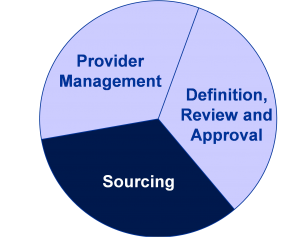There is no doubt that spending on services is climbing and climbing at a rapid pace. Most organizations have recognized this and have been trying to get a handle on this critical area. MSPs and the various software solutions out there are a clear example of that. While most of these efforts are very admirable and do a decent job of helping you manage this area, they still fall woefully short. And the reason is that they are only focused on one aspect of the entire conundrum.
Almost every time we help a client in this space, we are told that our focus should be on helping them get better at buying services; unfortunately that ignores what happens before the buy and what happens after. This is where a lot of leverage is left on the table – if you agree that leverage is far, far more than price. Here is some content from a slide from many years ago and is still mostly true?
“80 percent of F1000 enterprises do not have a formal process for procuring IT and business services.” – Gartner Group
“We have taken 20% – 25% out of our consulting and staffing costs through better sourcing and management of our providers” – Fortune 150 CFO
“Controlling and managing the cost and value derived from services expenditures is now an enterprise imperative.”- Meta Group
“Strategic sourcing and related procurement initiatives almost always overlook a huge savings / value opportunity – complex business services”
We believe that focusing on three core areas will allow organizations to achieve significant benefits.
Understanding what the review and approval process is for services spend is typically fairly basic, if there at all. If you’re hearing statements like this, it should be a wake-up call. It probably means that you don’t have a tight front end process which and are leaving a lot of leverage on the table.
“I don’t know if the money we spend on these services is justified. Sometimes I think we could have produced the same results.”
“Projects get approved which lack defined scopes, clear specifications or structured business cases.”
“We use consultants for some of our most critical projects, but we have no policy or process surrounding their use.”
You are, of course, familiar with the “sourcing” segment and have probably heard a number of statements like this?
“We don’t coordinate selection of our consultants or attempt to consolidate them.’
“I don’t know what we spend on consultants across the company. My gut tells me it’s more than we think…”
“Our evaluations suffer because we don’t have a formal process”
“Little, if any, sharing of experiences and knowledge occurs across our various buyers of consultants. “
What about the third segment. This is where the closed loop process comes in. If your organization is continuing to hire outside services for the same skill sets, perhaps you ought to be building that competency internally? Are the initiatives actually delivering the results promised? Did the project team come back and report results to the approving body? These are all significant leverage points that are often ignored.
“We put significant effort into negotiating our contracts, but rarely use them to actively manage the provider.”
“We must manage our relationships better-I know we end up paying different rates for the same services…”
“Once the consultants are here, the projects always seem to expand.”
“Our current processes do not provide adequate control over consulting expenditures.”
So go source your services spend. Get the best rates. But make sure you have a systems approach to this area and are focused on the highest leverage points.


